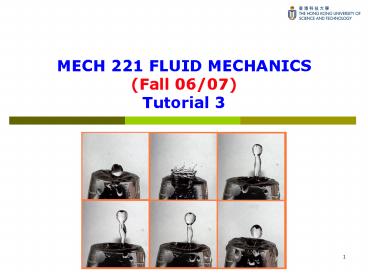MECH 221 FLUID MECHANICS (Fall 06/07) Tutorial 3
1 / 28
Title:
MECH 221 FLUID MECHANICS (Fall 06/07) Tutorial 3
Description:
... (64)(175.271)(15-4.108) =122179.311lb ft/ft (CCW) MA=MH-MV =147456-122179.311=24276.689lb ft/ft (CW) (moment per unit length) Wair, heated Wloading Wair, ... –
Number of Views:199
Avg rating:3.0/5.0
Title: MECH 221 FLUID MECHANICS (Fall 06/07) Tutorial 3
1
MECH 221 FLUID MECHANICS(Fall 06/07)Tutorial 3
2
Outline
- Absolute and gage pressure
- Forces on Immersed surface
- Plane surface
- Curved surface
- Buoyant force
3
1. Absolute and Gage pressure
- Absolute pressure
- Measured from absolute zero
- Gage pressure
- Measured from atmospheric pressure
- If negative, it is called vacuum pressure
- Pabs Patm Pgage
4
1. Absolute and Gage pressure
Gage pressure
Absolute pressure
Atmospheric pressure
5
1. Example
- A scuba diver practicing in a swimming pool takes
enough air from his tank to fully expand his
lungs before abandoning the tank at depth L and
swimming to the surface. When he reaches the
surface, the different between the external
pressure on him and the air pressure in his lung
is 9.3kPa. From what depth does he start?
6
1. Example (Answer)
- When the diver fills his lungs at depth L, the
external pressure on him (and thus the air
pressure within his lungs) is,P P0?gL - When he reaches the surface, the pressure
difference between his lung and surrounding
is,?P PP0 ?gLL ?P/?g 9300/(1000x9.81)
0.948m
7
2.1 Forces on Immersed Surfaces (plane surface)
- For plane surface
- F (Patm ?ghc.g)AOR F (Patm ?hc.g)A
- hc.g.vertical distance from the fluid surface to
the centroid of the area
8
2.1 Forces on Immersed Surfaces (plane surface)
- Where is the centroid.?
- By definition
9
2.1 Forces on Immersed Surfaces (plane surface)
- Centre of pressure
10
2.1 Forces on Immersed Surfaces (plane surface)
- What is Ixc (or Iyc).?
- By definition
11
2.1 Example
- The rectangular gate CD shown in the figure is
1.8m wide and 2.0 long. Assuming the material of
the gate to be homogeneous and neglecting
friction at the hinge C, determine the weight of
the gate necessary to keep it shut until the
water level rises to 2.0m above the hinge.
12
2.1 Example (Answer)
- Procedure
- Magnitude of the resultant force
- FR ?ghc.g.A ? hc.g. ?
- Centre of pressure yc.p.
- yc.p. (Ixc/yc.g.A) yc.g. ? yc.g. ? Ixc ?
- Moment balance at hinge C
- SM 0
13
2.1 Example (Answer)
- hc.g.20.5(4/5)(2)2.8m
- FR(9.81)(1000)(2.8)(2)(1.8)98.885kN
- yc.p. (Ixc/yc.g.A) yc.g.
- yc.g.2.8(5/4)3.5m
- Ixc(1/12)(1.8)(2)31.2m4
- yc.p.1.2/(3.5x2x1.8)3.53.595m
- Moment equilibrium
- Resultant force MFFR(yc.p.-2(5/4)) 108.279kNm
- Weight of the gate MgW(0.5)(2)(3/5)0.6W
- Since MFMg ? 0.6W108.279 W180.465kN
14
2.2 Forces on Immersed Surfaces (curved surface)
- For curved surface
- Horizontal force horizontal force on a curved
surface equals the force on the plane area formed
by the projection of the curved surface onto a
vertical plane
15
2.2 Forces on Immersed Surfaces (curved surface)
- For curved surface
- Vertical force
- Similar to the previous approach,
- FaV Fa cos? Pa Aacos ?
- Aacos? is the horizontal projection of 'a', but
this is only at a point! - Notice that if one looks at the entire plate, the
pressures on the horizontal projection are not
equal to the pressures on the plate - Consequently, one needs to integrate along the
curved plate
16
2.2 Example
- The concrete seawall has a curved surface and
restrains seawall at a depth of 24ft. The trace
of the surface is a parabola as illustrated.
Determine the moment of the fluid force (per unit
length) with respect to an axis through the toe
(point A).
17
2.2 Example (Answer)
- Procedure
- Magnitude of the horizontal force
- FH ?hc.g.A ? hc.g. ?
- Magnitude of the vertical force
- FV ?V
- Volume? Location of centroid?
- Moment at hinge A
18
2.2 Example (Answer)
- Horizontal force and pressure centre
- hc.g.y124/2 12ft
- FHF1 ?hc.g.A (64)(12)(24) 18432lb/ft
- y124/38ft
19
2.2 Example (Answer)
- Volume of the seawater
- Given the function of the surface
- y0.2x2
- When y24ft, x0v120
20
2.2 Example (Answer)
- Location of the centroid
- Given the function of the surface
- y0.2x2, x0v120, A175.271ft2
21
2.2 Example (Answer)
- Moment at point A
- MHFHy1(18432)(8)147456lbft/ft (CW)
- MVW(15-xc)(64)(175.271)(15-4.108)122179.311lb
ft/ft (CCW) - MAMH-MV147456-122179.31124276.689lbft/ft
(CW)(moment per unit length)
22
3. Buoyant force
- FB?g(vol. a-b-c-d)
- This force FB is called Buoyant Force
23
3. Example
- A hot-air balloon weights 500lb. The air outside
the balloon has a temperature of 80?F, and the
heated air inside the balloon has a temperature
of 150?F. Assume the inside and outside air to be
at standard atmospheric pressure of 14.7psi.
Determine the required volume of the balloon to
support the weight. If the balloon had a
spherical shape, what would be the required
diameter?
24
3 Example (Answer)
- Procedure
- Buoyant force of air
- FB ?air, outsideV
- Total weight of the balloon
- W Wloading Wair, inside
- SFvert 0
25
3 Example (Answer)
- By ideal gas law
- pV mRT ? pg/RT
- For air_at_14.7psi,80?F
- ?air, outside pg/RT (14.7)(144)(32.2)/(1716)(
80460) 0.07356lb/ft3 - Buoyant force of air
- FB ?air, outsideV 0.07356V
26
3 Example (Answer)
- For air_at_14.7psi,150?F
- ?air, inside pg/RT (14.7)(144)(32.2)/(1716)(1
50460) 0.06512lb/ft3 - Total weight of the balloon
- W Wloading Wair, inside
- W 500 ?air, insideV 500 0.06512V
27
3 Example (Answer)
- By force equilibrium,
- FB W
- 0.07356V 500 0.06512V
- V 59241.706ft3
- Also, V (p/6)D3
- D 48.366ft
28
The End































